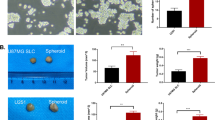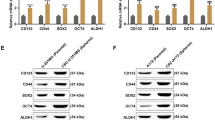Abstract
The search of biomarkers for early diagnosis and theranostics of glioblastoma multiforme (GBM) due to the aggressiveness of the disease is an urgent needed. In the present work, the expression of the heat-shock protein Hsp70 was detected and a quantitative assessment of its colocalization with markers of tumor stem-like cells (TSLCs) was made using the multiplex method of analysis of histological preparations of GBM. Cells expressing Hsp70 are uniformly distribution in the tumor and have colocalization with Nestin and Sox2, indicate the promise of using Hsp70 as a target for targeted therapy of malignant brain tumors.



Similar content being viewed by others
REFERENCES
Albakova, Z.A., Grigoriy, A., Kanevskiy, L.M., Kovalenko, E.I., and Sapozhnikov, A.M., HSP70 multi-functionality in cancer, Cells, 2020, vol. 9, p. 587. https://doi.org/10.3390/cells9030587
Barreca, M.M., Spinello, W., Cavalieri, V., Turturici, G., Sconzo, G., Kaur, P., Tinnirello, R., Asea, A., and Geraci, F., Extracellular Hsp70 enhances mesoangioblast migration via an autocrine signaling pathway, J. Cell Physiol., 2017, vol. 232, p. 1845. https://doi.org/10.1002/jcp.25722
Breuninger, S., Stangl, S., Werner, C., Sievert, W., Lobinger, D., Foulds, G.A., Wagner, S., Pickhard, A., Piontek, G., and Kokowski, K., Membrane Hsp70—a novel target for the isolation of circulating tumor cells after epithelial-to-mesenchymal transition, Front. Oncol., 2018, vol. 8, p. 497. https://doi.org/10.3389/fonc.2018.00497
Gallego, O., Nonsurgical treatment of recurrent glioblastoma, Curr. Oncol., 2015, vol. 22, p. 273. https://doi.org/10.3747/co.22.2436
Kumar, S., Stokes, J., Singh, U.P., Gunn, K.S., Acharya, A., Manne, U., and Mishra, M., Targeting Hsp70: a possible therapy for cancer, Cancer Lett., 2016, vol. 374, p. 156. https://doi.org/10.1016/j.canlet.2016.01.056
Matsuda, Y., Naito, Z., Kawahara, K., Nakazawa, N., Korc, M., and Ishiwata, T., Nestin is a novel target for suppressing pancreatic cancer cell migration, invasion and metastasis, Cancer Biol. Ther., 2011, vol. 11, p. 512. https://dx.doi.org/10.4161%2Fcbt.11.5.14673
Matsuda, Y., Ishiwata, T., Yoshimura, H., Hagio, M., and Arai, T., Inhibition of nestin suppresses stem cell phenotype of glioblastomas through the alteration of post-translational modification of heat shock protein HSPA8/HSC71, Cancer Lett., 2015, vol. 357, p. 602. https://doi.org/10.1016/j.canlet.2014.12.030
Mimeault, M. and Batra, S.K., Altered gene products involved in the malignant reprogramming of cancer stem/progenitor cells and multitargeted therapies, Mol. Aspects Med., 2014, vol. 39, p. 3.
Mori, H., Bolen, J., Schuetter, L., Massion, P., Hoyt, C., Vanden Berg, S., Esserman, L., Borowsky, A., and Campbel, M., Characterizing the tumor immune microenvironment with tyramide‑based multiplex immunofluorescence, J. Mammary Gland Biol. Neoplasia, 2020, vol. 25, p. 417. https://doi.org/10.1016/j.mam.2013.08.001
Muir, M., Gopakumar, S., Traylor, J., Lee, S., and Rao, G., Glioblastoma multiforme: novel therapeutic targets, Expert Opin. Ther. Targets, 2020, vol. 24, p. 605. https://doi.org/10.1080/14728222.2020.1762568
Novak, D., Hüser, L., Elton, J.J., Umansky, V., Altevogt, P., and Utikal, J., SOX2 in development and cancer biology, Semin. Cancer Biol., 2020, vol. 67, part 1, p. 74. https://doi.org/10.1016/j.semcancer.2019.08.007
Parlato, C., Barbarisi, M., Moraci, M., and Moraci, A., Surgery, radiotherapy and temozolomide in treating high-grade gliomas, Front. Biosci., 2006, vol. 1, p. 1280. https://doi.org/10.2741/1881
Pfister, K., Radons, J., Busch, R., Tidball, J.G., Pfei-fer, M., Freitag, L., Feldmann, H.J., Milani, V., Issels, R., and Multhoff, G., Patient survival by Hsp70 membrane phenotype: Association with different routes of metastasis, Cancer, 2007, vol. 110, p. 926.
Phillips, H.S., Kharbanda, S., Chen, R., Forrest, W.F., Soriano, R.H., Wu, T.D., Misra, A., Nigro, J.M., Col-man, H., Soroceanu, L., Williams, P.M.Y., Modrusan, Z., Feuerstein, B.G., and Aldape, K., Molecular subclasses of high-grade glioma predict prognosis, delineate a pattern of disease progression, and resemble stages in neurogenesis, Cancer Cell, 2006, vol. 9, p. 157. https://doi.org/10.1016/j.ccr.2006.02.019
Razavi, S.M., Lee, K.E., **, B.E., Aujla, P.S., Gholamin, S., and Li, G., Immune evasion strategies of glioblastoma, Front. Surg., 2016, vol. 3, p. 11. https://doi.org/10.3389/fsurg.2016.00011
Sasmita, A.O., Wong, Y.P., and Ling, A.P.K., Biomarkers and therapeutic advances in glioblastoma multiforme, Asia Pac. J. Clin. Oncol., 2018, vol. 14, p. 40.https://doi.org/10.1111/ajco.12756
Shevtsov, M., Balogi, Z., Khachatryan, W., Gao, H., Vigh, L., and Multhoff, G., Membrane—associated heat shock proteins in oncology: from basic research to new teranostic targets, Cells, 2020, vol. 9, p. 1263. https://doi.org/10.3390/cells9051263
Sidi, F., Bingham, V., Craig, S., McQuaid, S., James, J., Humphries, M., and Salto-Tellez, M., PD-L1 multiplex and quantitative image analysis for molecular diagnostics, Cancers, 2021, vol. 13, p. 29. https://doi.org/10.3390/cancers13010029
Taube, J., Roman, K., Engle, E., Wang, C., Ballesteros-Merino, C., Jensen, S., McGuire, J., Jiang, M., Coltharp, C., Remeniuk, B., Wistuba, I., Locke, D., Parra, E., Fox, B., Rimm, D., and Hoyt, C., Multi-institutional TSA-amplified multiplexed immunofluorescence reproducibility evaluation (MITRE) study, J. Immunother. Cancer, 2021, vol. 9, article ID e002197. https://doi.org/10.1136/jitc-2020-002197
Thorsteinsdottir, J., Stangl, S., Fu, P., Guo, K., Albrecht, V., Eigenbrod, S., Erl, J., Gehrmann, M., Tonn, J.C., and Multhoff, G., Overexpression of cytosolic, plasma membrane bound and extracellular heat shock protein 70 (Hsp70) in primary glioblastomas, J. Neurooncol., 2017, vol. 135, p. 443. https://doi.org/10.1007/s11060-017-2600-z
Uozaki, H., Ishida, T., Kakiuchi, C., Horiuchi, H., Gotoh, T., Iijima, T., Imamura, T., and Machinami, R., Expression of heat shock proteins in osteosarcoma and its relationship to prognosis, Pathol. Res. Pract., 2000, vol. 196, p. 665. https://doi.org/10.1016/S0344-0338(00)80118-1
Vargas-Toscano, A., Janiak, C., Sabel, M., and Kahlert, U., A preclinical pipeline for translational precision medicine-experiences from a transdisciplinary brain tumor stem cell project, J. Pers. Med., 2021, vol. 11, p. 892. https://doi.org/10.3390/jpm11090892
ACKNOWLEDGMENTS
The authors express their deep gratitude to the BioLine LLC Group for the reagents and equipment provided for the work, as well as to Darya Dyakova, an employee of this company, for her help in preparing and analyzing preparations.
Funding
This work was supported by the Russian Foundation for Basic Research, project no. 19-58-55001.
Author information
Authors and Affiliations
Corresponding author
Ethics declarations
Conflict of interest. The authors declare that they have no conflict of interest.
Statement of compliance with standards of research involving humans as subjects. The protocol of the clinical trial was approved by the Ethics Committee of the Almazov Federal Medical Research Center. All patients signed an informed consent to provide material for research.
Additional information
Abbreviations: IHC, immunohistochemistry; IF, immunofluorescence; GBM, glioblastoma multiforme; TSLCs, tumor stem-like cells; DAB, 3,3'-diaminobenzidine; HSP, heat-shock protein; PBS, phosphate-buffered saline solution.
Rights and permissions
About this article
Cite this article
Yudintceva, N.M., Mikhrina, A.L., Nechaeva, A.S. et al. Assessment of Heat-Shock Protein Hsp70 Colocalization with Markers of Tumor Stem-Like Cells. Cell Tiss. Biol. 16, 459–464 (2022). https://doi.org/10.1134/S1990519X22050108
Received:
Revised:
Accepted:
Published:
Issue Date:
DOI: https://doi.org/10.1134/S1990519X22050108




